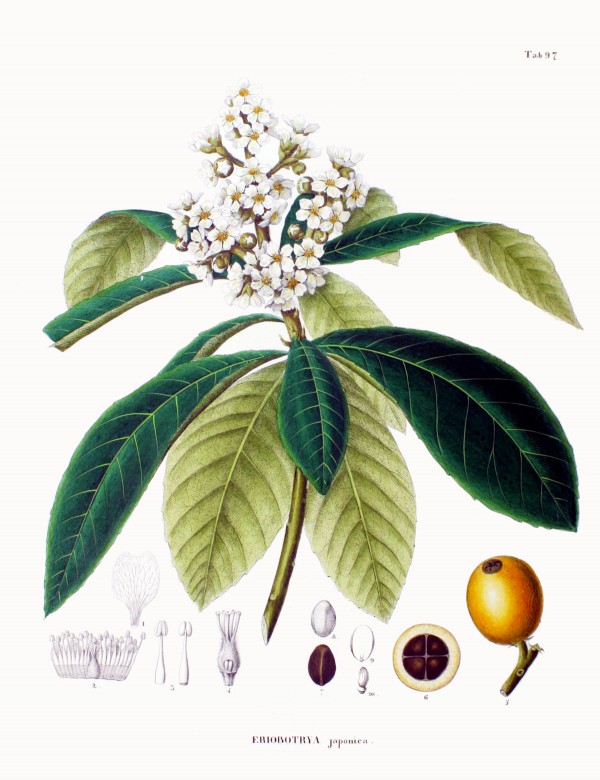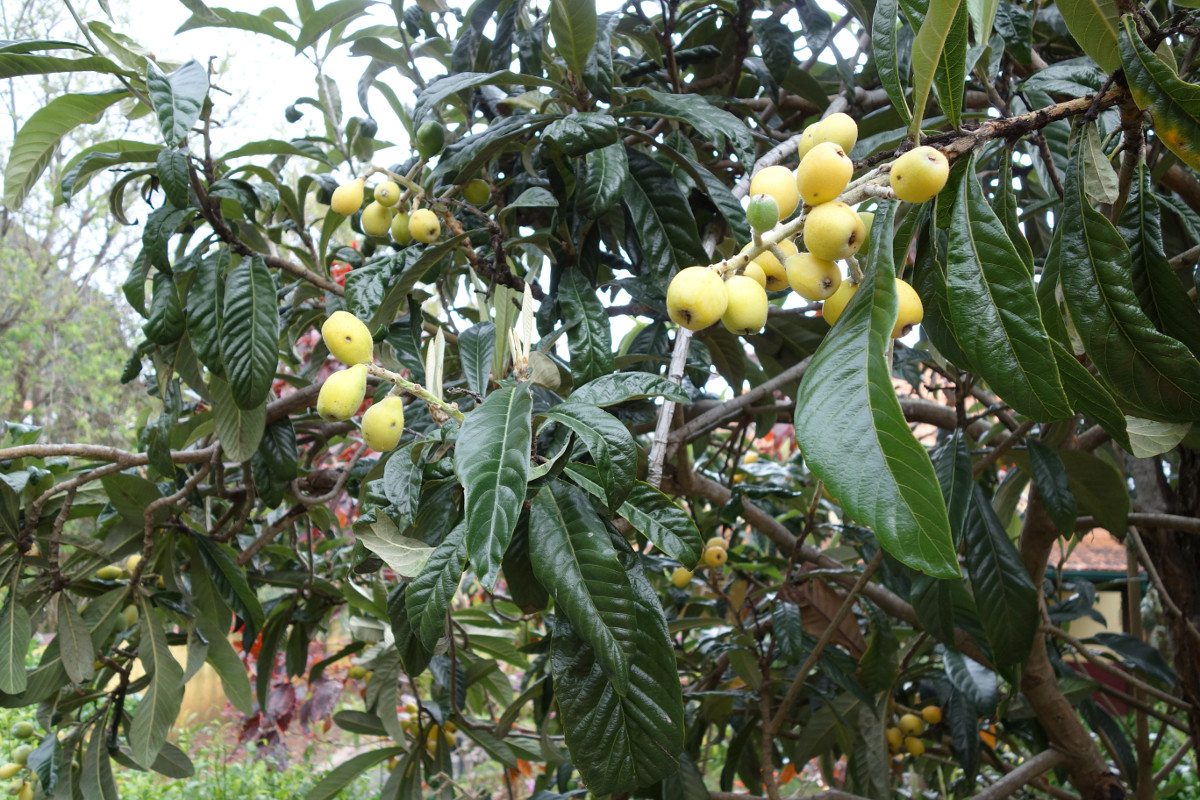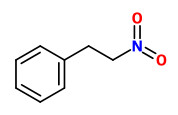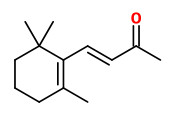Benutzer-Werkzeuge
Eriobotrya japonica (Thunb.) Lindl. - syn. Mespilus japonica Thunb. - Rosaceae
loquat, Japanese medlar, Japanische Wollmispel, Japanische Mispel, Loquat
Large evergreen shrub or tree, up to 10m tall, native to Eastern Asia (China, Korea and Japan), cultivated throughout SE Asia as an ornamental plant and also commercially for its fruit; leaves leathery, lanceolate, oblanceolate, obovate, or elliptic-oblong, up to 30cm long; panicles many-flowered, flowers fragrant, 1-2cm in diameter, petals white; fruit pome yellow or orangish yellow, globose or obovate, rusty tomentose, soon glabrescent.
http://www.efloras.org/florataxon.aspx?flora_id=2&taxon_id=200010834
„Loquats are unusual among fruit trees in that the flowers appear in the autumn or early winter, and the fruits are ripe at any time from early spring to early summer. The flowers are 2 cm (1 in) in diameter, white, with five petals, and produced in stiff panicles of three to ten flowers. The flowers have a sweet, heady aroma that can be smelled from a distance… The fruits [3-5cm long] are the sweetest when soft and orange. The flavour is a mixture of peach, citrus and mild mango.“
https://en.wikipedia.org/wiki/Loquat
2-Nitroethyl benzene (1-nitro-2-phenylethane, 32.5%) was identified as a major component of the flower scent of the Japanese loquat Eriobotrya japonica, together with 4-methoxybenzaldehyde (anisaldehyde, 27.1%) and methyl 4-methoxybenzoate (methyl anisate, 24.5%). Minor components were e.g. benzaldehyde (1.6%), phenylethanol (3.3%), 2-phenylacetonitrile (0.9%), 2-phenylacetoaldoxime (0.8%), and methyl cinnamate (7.1%).
[Kuwahara, Yasumasa, et al. „(2-Nitroethyl) benzene: a major flower scent from the Japanese loquat Eriobotrya japonica [Rosales: Rosaceae].“ Bioscience, biotechnology, and biochemistry 78.8 (2014): 1320-1323] https://www.tandfonline.com/doi/full/10.1080/09168451.2014.921558
Of the 18 compounds identified in a methylene chloride extract of a distilled fraction from loquat fruit,
major components were phenylethanol, 3‐hydroxy‐2‐butanone, phenylacetaldehyde and hexen‐1‐ols. Minor components were ethyl acetate, methyl cinnamate and β‐ionone.
[Shaw, P. E., and C. W. WILSON III. „Volatile constituents of loquat (Eriobotrya japonica Lindl.) fruit.“ Journal of Food Science 47.5 (1982): 1743-1744]
„Concentrates of fresh, ripe Spanish loquat fruit were analyzed by HRGC, HRGC‐MS and HRGC‐FTIR. In total, 80 aroma substances were identified, of which 72 are reported for the first time as loquat fruit constituents. The major part of volatiles comprised alcohols and carbonyls. Quantitative HRGC revealed hexanal (2.4 mg/kg fruit pulp), (E)‐2‐hexenal (1.8 mg/kg) and benzaldehyde (0.7 mg/kg) as major aroma compounds.“
[Fröhlich, O., and P. Schreier. „Volatile constituents of loquat (Eriobotrya japonica Lindl.) fruit.“ Journal of food science 55.1 (1990): 176-180]
„The most potent aroma compound in fresh loquat was phenylacetaldehyde (FD factor=256). Other aroma compounds having FD factor=64 included hexanal, (E)-2-hexenal, hexanoic acid and β-ionone, which may play important roles in fresh loquat aroma. The most potent aroma compound in the canned product was β-ionone (FD factor=256). After 3 months storage at room temperature, furfural (FD factor=4) and 5-methyl-2-furfural (FD factor=1) were perceived by GC-O. When stored at 37°C for 3 months, the FD factor of furfural increased to 64. “
[Takahashi, H., et al. „Potent aroma volatiles in fresh loquat and its canned product.“ Nippon Shokuhin Kagaku Kogaku Kaishi= Journal of the Japanese Society for Food Science and Technology 47.4 (2000): 302-310]

Eriobotrya japonica (Thunb.) Lindl.; P.F. von Siebold, J.G. Zuccarini, Flora Japonica, t.97 (1875)
http://botanicalillustrations.org/species.php?id_species=399048

Eriobotrya japonica, Madeira (2018) CC BY-SA 3.0, Author: Andreas Kraska




